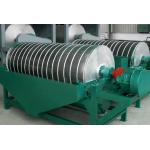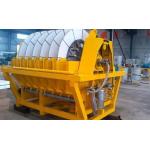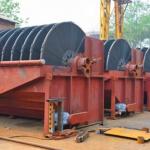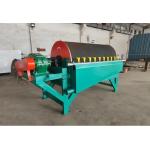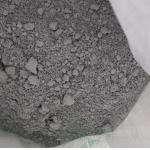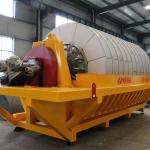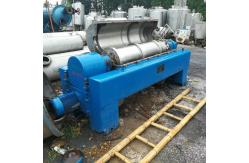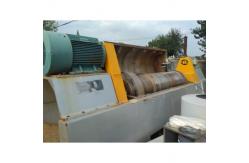Automatic Operation Ore Dressing Equipment Horizontal Decanter
Centrifuge
1. Working principle of sedimentation centrifuge Ore Dressing Equipment
A centrifuge for separating suspension components by centrifugal
sedimentation. The suspension added to the drum forms a circular
liquid layer under the action of centrifugal force, in which the
solid particles settle onto the drum wall and form sediment. The
clarified liquid is discharged through the drum overflow port or
suction pipe, called separation liquid. The sediment is discharged
manually or mechanically at the end of separation. Solid particles
in the process of settling to the drum wall, but also with the
liquid flow for axial movement, when the feed amount is too large,
with the liquid flow to the overflow mouth, and has not settled to
the wall of the fine particles with the separation liquid
discharged to the drum, so that the separation liquid turbidity.
For the difficult to separate suspension with small density
difference between solid and liquid phase, small solid particles or
large liquid viscosity, a sedimentation centrifuge with high
separation factor should be selected to prolong the suspension's
stay time in the drum (such as reducing the feed amount or using a
long drum, etc.), so as to ensure the clarification of the
separation liquid. Sedimentation centrifuge has a wide range of
uses, especially suitable for centrifugal filtration because solid
particles are easy to block the filter medium and filtration
resistance is too large or fine particles leakage is too much
suspension separation, but the moisture content of sediment is
high. Sedimentation centrifuge can be used for crystallization,
chemical precipitation, coal and other suspension separation,
dehydration of sewage sludge and animal and plant oil residue
clarification, etc.
2. TCL, TC series sedimentation centrifuge technical
performance: Ore Dressing Equipment
| Item | Unit | Model |
| TCL-0918 | TCL-0924 | TCL-1134 | TCL-1418B | TCL-0924 | TCL-1134 |
| Diameter of big end of drum | mm | 900 | | 1104 | 1358 | 900 | 1100 |
| Drum length | mm | 1722 | | 3212 | 1868 | 2440 | 3350 |
| Drum speed | r/min | 800;1000 | | 900;1100;1300 | 480;550;650 | 1000 | 850 |
| Main motor power | Kw | 100 | | 300 | 190 | 110 | 300 |
| Handle material | | Flotation cleaned coal | Flotation cleaned coal | Flotation cleaned coal | Pipeline coal | Flotation cleaned coal | Wast coal | Wast coal |
| Feed material concentration | % | 25~35 | 25~35 | ≥30 | 50 | 25~35 | | |
Processing capacity (Dry materials) | t/h | 10~20 | 15~25 | 40~50 | 50~60 | 10~25 | 15~30 |
| Product water | % | 15~20 | 15~20 | 15~20 | 13~20 | 30~35 | 30~35 |
| Dimension | L | mm | 4.04 | 4.64 | 9.22 | 470 | 4.82 | |
| W | mm | 3.5 | 3.28 | 2.96 | 3.996 | 2.9 | |
| H | mm | 1.47 | 1.47 | 2.47 | 2.05 | 1.46 | |
| Machine weight | t | 11.34 | 11.9 | 24 | 18 | 13 | |
3. Ore Dressing Equipment Decanter Centrifuge Drum structure
and feeding mode
According to the research data of centrifuge developed abroad in
recent years, the structure of rotary drum has positive cup type
and inverted cup type, and the corresponding feeding modes are up
feed mode and down feed mode. Scientific research machines and
engineering machines in our country use inverted cup drum and feed
system. The advantages are that the length of the main shaft is
shortened, the superstructure is simplified, the slag discharge is
smooth, and there is less pollution above the operation. The
process pipeline is centrally arranged under the drum, which is
conducive to the lifting, maintenance and solution of α seal of the
drum.
